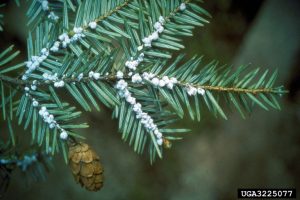The public first learned about the arrival of the hemlock wooly adelgid, appropriately labelled the Hemlock Vampies, in August. At that time we were told:
To date, hemlock woolly adelgid has been found in Digby, Yarmouth and Shelburne counties. The CFIA continues to conduct surveys in the areas where the pest was found to determine its spread. Regulatory measures will be put in place as required once the survey work is completed. – CFIA News release Aug 3, 2017
Now that survey is done, Queens and Annapolis Counties have been added to the list and restrictions on movement from wood in those counties imposed.
View CFIA insect rules trap wood products in 5 Nova Scotia countiesby David Burke for CBC, Jan 09, 2018

Hemlock Woolly Adelgid. “Their name comes from waxy white filaments they make to protect themselves from drying out. In a heavy infestation, hemlock trees can look gray from all the “wool” on twigs and branches. They can’t fly, but are spread by wind and also hitch rides on the feet of birds, which can carry hemlock wooly adelgids for long distances. These “hemlock vampires” were first discovered in 1951 in Virginia, and by 2005 had spread to fifteen other states.
Source: Paul Hetzler, Cornell Cooperative Extension
Photo source: Connecticut Agricultural Experiment Station, Bugwood.org
In an email, the CFIA told CBC News that the movement restrictions will remain in place indefinitely. If producers want to move their product out of the restricted area they need to get a certificate from the CFIA to do so. The only way to get one is to follow CFIA policies to ensure that the insects are not introduced into non-infested areas.
I wish we could turn the clock back on this one.
Related:
Amherst hosting Atlantic forestry workshop
Cumberland News Now, Jan 09, 2018
Some of Atlantic Canada’s top researchers will be in Amherst to discuss the health of the region’s forests during an Atlantic Canada Forest Health Workshop that begins on Jan. 16. The workshop will focus on invasive pests with research data from the Atlantic Provinces natural resources departments, the Canadian Food Inspection Agency, Natural Resources Canada-Canadian Forest Service and the Maine Forest Service being presented.
UPDATE Jan 11, 2017
I just received the Jan 2018 issue of Atlantic Forestry. It has two items on the wooly adelgid:
(i) Hemlocks under threat, by Zack Metcalfe. pages 14-16. Amongst others, Zack interviewed Ron Neville, a CFIA survey biologist who investigated the first report of HWA (hemlock wooly adelgid) in Nova Scotia (July 2017) and conducted follow-up surveys. It is already widespread in Digby, Yarmouth and Shebourne counties but Queens and Annapolis host only small pockets.
(ii) AFR has its own piece, Adelgid Expert, pp 16 and 17, about comments by Dr Mark Whitmore, a forest entomologist with Cornell University who “visited Nova Scotia in mid-December to share his experience and to help formulate a local response.” In a nutshell, there are biological controls that can be introduced; we want to try to hold it back as much as possible in the meantime, using insecticides [and controls of movement of wood] as necessary until we can get those into place.
‘Best to get a copy of Atlantic Forestry Review January 2018 issue and read both articles and lots more about forestry in the Atlantic Provinces.
ADDENDUM, Jan 29, 2018: They who kill the hemlocks
Zack Metcalfe in CH South Shore Breaker

